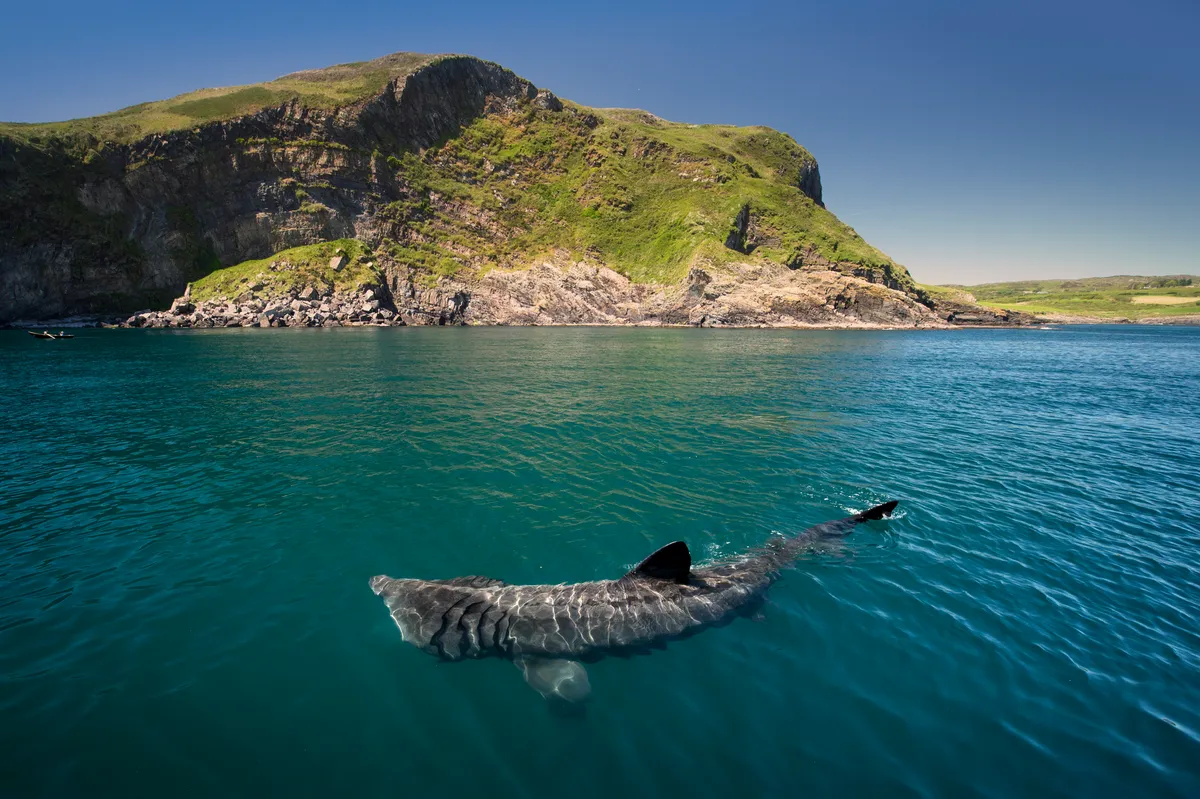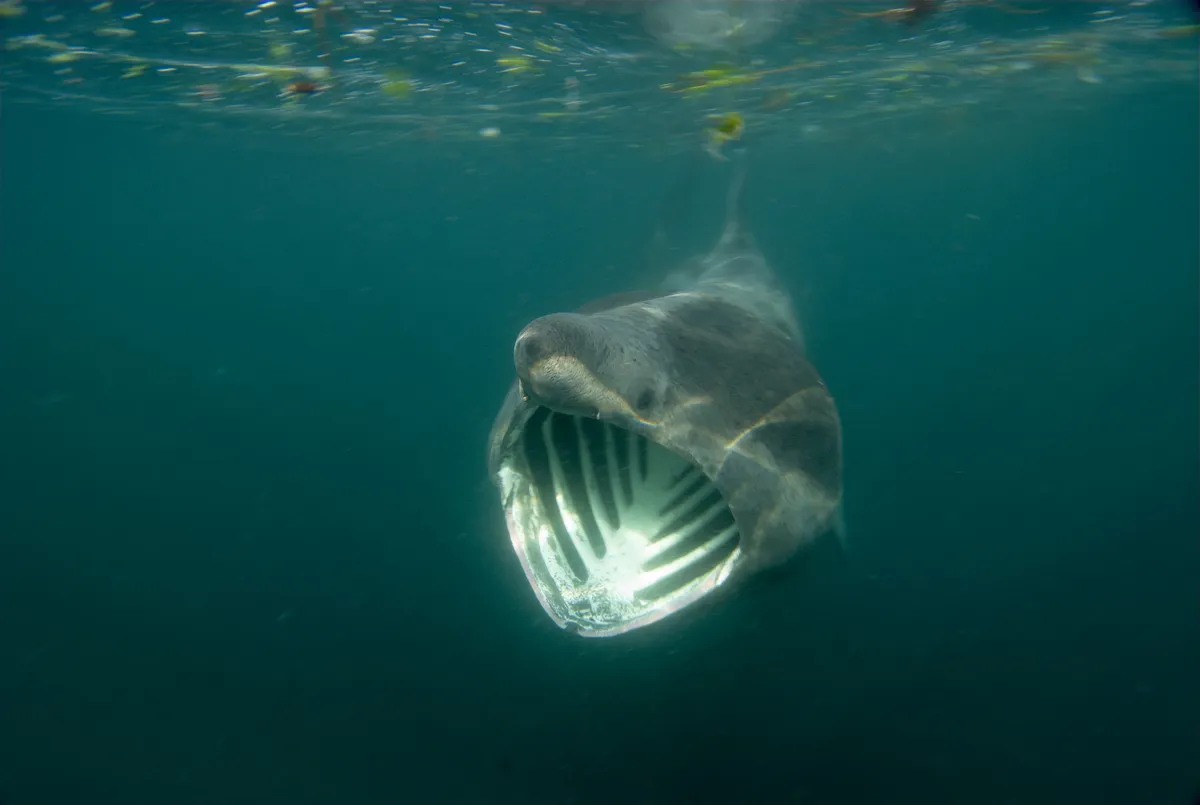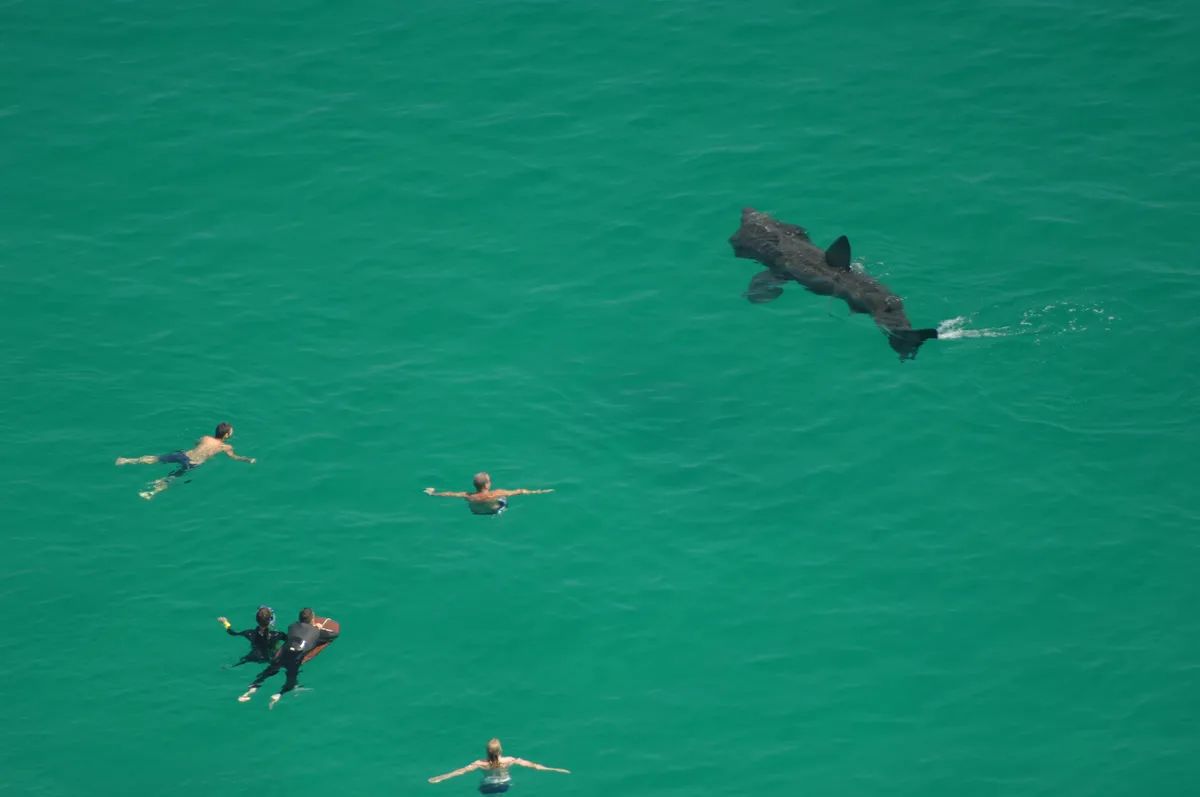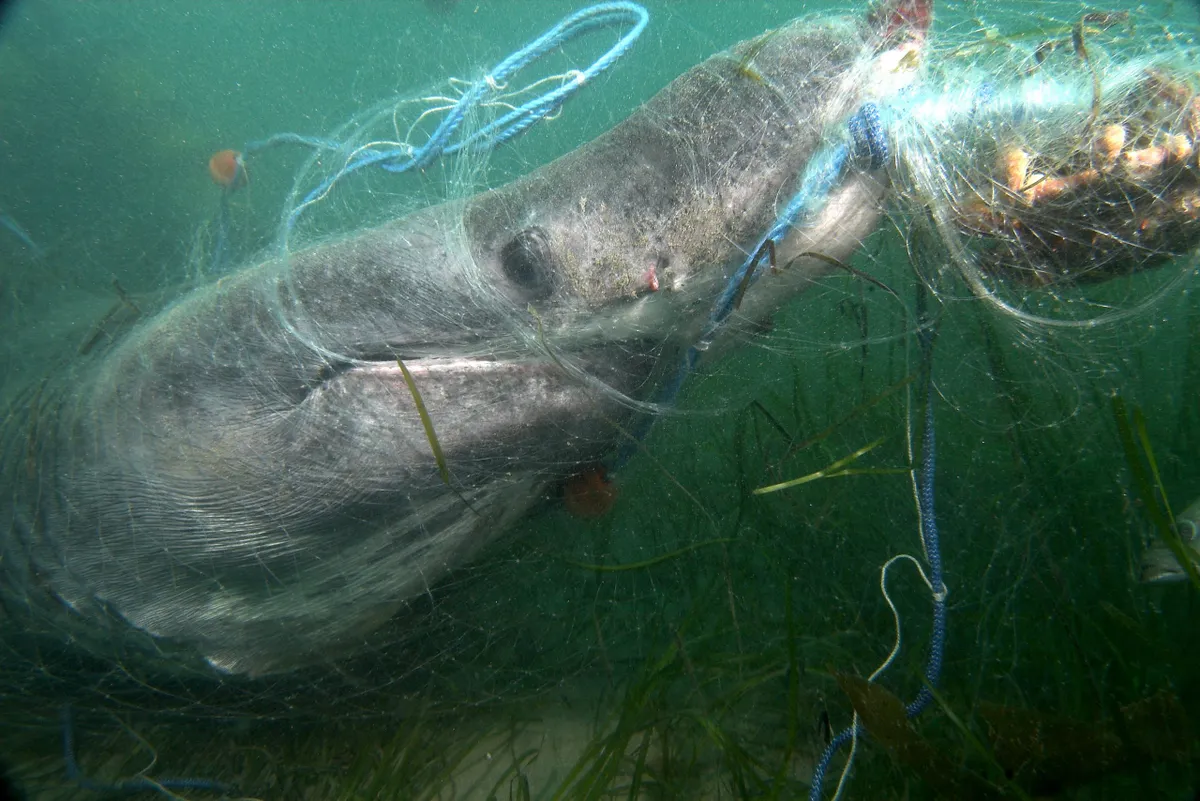We’re lucky to have access to nature programmes that serve up a rich diet of charismatic wildlife from far-flung locations. Such is the spotlight on exotic destinations, however, viewers could be forgiven for assuming that it’s only elsewhere on the planet that the biggest and best wildlife spectacles are taking place. Fortunately, that’s not the case at all – truly world-class wild experiences do occur closer to home, with the seasonal appearance of the oceans’ second-largest fish being a prime example.
Deferring only to the whale shark in size, the basking shark is Britain’s largest fish by a metaphorical country mile. Matching a double-decker bus in length and tipping the scales at about seven tonnes, these gargantuan dimensions may give the impression of a fearsome monster. Their appearance, however, belies their true nature: basking sharks definitely fall into the category of ‘gentle giant’. Despite their immense size, basking sharks are not dangerous to humans.
Learn more about these incredible sharks in our expert guide by the Marine Conservation Society (MCS) with contributions from naturalist Mike Dilger (MD).
Learn more about sharks:
Where are basking sharks found?
Basking sharks can be found in cold to temperate waters all over the world and are normally seen in UK waters between April and October every year.
The most common hotspots include south-west Cornwall, around the Isle of Man and up and down the west coast of Scotland.

The Marine Conservation Society have, however, had sightings reported to their Basking Shark Watch citizen science project from all over the UK. So it’s always worth looking out to sea, especially in the summer months, for those bulbous noses and tall fins breaking through the surface of the water.
What is the scientific name of the basking shark?
The scientific name for basking sharks is Cetorhinus maximus and belong to the order Lamniformes which is known as the mackerel sharks.
This order includes other famous sharks such as the great white and the megamouth shark.
How to identify basking sharks
Basking sharks are the second biggest fish in the sea and can grow to over 10m long. The only other shark that is bigger is the whale shark.
They have big, bulbous noses that stick out of the water when they are feeding near the surface, followed by a big dorsal fin and a tail fin at the end. Most of the time you will see them with their huge mouths wide open swimming into the current to feed.

What do basking sharks eat?
Although part of the same order, basking sharks do not share the same diet as their seal-eating great white cousins. Despite being the second largest fish in the sea, growing to over 10m long, they eat some of the smallest creatures in the ocean: plankton, specifically, zooplankton.
These microscopic animals live in the sea water and are captured by basking sharks as they swim through the water with their mouths wide open, filtering the plankton out of the water as they go.

How does filter-feeding work?
Swimming along at a speed of about two knots while holding its cavernous mouth wide open, the basking shark is a passive feeder. Its technique involves sieving zooplankton from the equivalent of an Olympic-size swimming pool’s worth of seawater every hour. Any food is trapped by specialised mucus-laden gill-rakers, with the water then passing over the shark’s gills – where dissolved oxygen is extracted – before finally being expelled through long, modified gill slits.
While actively feeding, the shark’s gullet is firmly closed to prevent the accidental ingestion of water, and only opens for swallowing food once the mouth is firmly shut. So effective is this technique that in good feeding areas it has been estimated that a basking shark’s stomach may contain up to half a tonne of food at any one time. MD
What is zooplankton?
Zooplankton consists of an array of microscopic copepods (small crustaceans), fish eggs and the larvae of gastropods (molluscs) and decapods (crustaceans). Collectively, they are a vital link in the marine food-web and a principal food for a vast array of fish and the largest whales.
What eats basking sharks?
The basking shark does not have many predators, however, could be eaten perhaps by another big shark or a hungry pod of 0rca (also known as killer whales).
What are baby basking sharks called?
Baby sharks are known as ‘pups’ which includes baby basking sharks. We do not know much about basking shark pups or where they are born.
We do know that the mothers give birth to live young rather than lay eggs, but we still have much more to learn about the early years of basking sharks.
How long do basking sharks live for?
According to the Shark Trust, females don’t mature until 20 years of age “It's thought that basking sharks live for at least 50 years. Males reach maturity at 12–16 years. And females at 20 years (around 4.6-6.1m in length).”
So as might be expected for such a large animal, they could likely live for several decades.
Are basking sharks endangered?
Thought to live to at least 50 years of age, the shark’s low reproductive rate makes it extremely vulnerable to hunting. Historically fished for their liver oil, skin, meat and fins, the global population became so severely depleted that in 2018 the International Union for Conservation of Nature (IUCN) classified the basking shark as endangered. The good news is these animals are now heavily protected in the UK, European Union and across much of their range, with the result that numbers seem to have stabilised. MD
Are basking sharks dangerous to humans?
Not directly as they are gentle plankton feeders, only if a small boat was to perhaps get in the path of a large shark feeding at the surface, which is why it is important when at sea to always abide by the recommendations of the WiSE scheme and only to go wildlife watching with boats accredited to this scheme.
In Scotland, the Nature Conservation (Scotland) Act 2004 (mentioned above) required production of a Marine Wildlife Watching Code which should be abided by for wildlife encounters in Scotland.

What threats do basking sharks face now?
Basking sharks are at risk globally because of the value of their fins, for which they are directly targeted. They are also at risk of propeller damage from collision with boats and of entanglement in fishing gear, particularly the lines for static gear such as pots and creels for catching lobsters and crabs.
“Scottish Natural Heritage advises that, in order to conserve basking sharks and minke whales, risk of injury and death should be minimised, access to resources within the site should be maintained, and supporting features should also be conserved.

The management advice to reduce these pressures includes:
- Use of best practice to reduce risk of boat collision;
- Reduce disturbance from noisy activities through best practice mitigation;
- Exclusion of drift and set net fishing gear;
- Further development and adoption of best practice to avoid entanglement in creel ropes;
- Management of fishing activities for key prey species e.g. herring and sprat;
- Exclusion of targeted fishing for sandeels;
- Use of best practice to reduce fishing bycatch;
- Consideration of new or altered ferry routes to reduce collision risk; and
- Minimising impacts to sandeel habitat through appropriate siting of new developments.”
Do basking sharks reproduce in the UK?
Surprisingly little is known about basking shark reproduction, but their courtship can occasionally be seen in British and Irish waters. Signs that love is in the water will include nose-to-tail following, parallel swimming and even breaching. MD
What work is being done to conserve basking sharks?
In the UK basking sharks are protected under:
- Schedule 5 of the Wildlife and Countryside Act 1981
- Countryside Rights of Way Act 2000
- Wildlife (Northern Ireland) Order 1985
- Nature Conservation (Scotland) Act 2004
These Acts make it illegal to intentionally kill, injure or harass basking sharks in British waters. Any person committing such an offence could face up to 6 months in prison and a large fine.
They’re also protected under:
- Common Fisheries Policy (CFP) - In 2007 basking sharks became a Prohibited Species in the EU. EU commercial fishing vessels are prohibited from targeting, retaining, trans-shipping or landing them. And this also applies to third country vessels in EU waters.
- UK Biodiversity Action Plan (BAP) - In 1997 the basking shark was listed in the UK BAP - an inventory of the nation’s biodiversity. This identified the basking shark as being in urgent need of conservation management and laid out detailed plans for their protection.
In 2009, the Scottish Government consulted on the Sea of the Hebrides proposed Marine Protected Area, in addition to another three new inshore MPAs in Scottish waters, which if designated would be the first MPA of its kind in the world.
MCS teamed up with the Scottish Wildlife Trust to show public support for this proposed MPA (and the other three) which was supported by over 3,300 public responses. The Sea of the Hebrides off the west coast of Scotland is one of the most important places in the world for basking sharks and the MCS hopes that it can become a MPA to provide even more protection in UK waters for these gentle giants.
Global protection:
- International Union for Conservation of Nature (IUCN) - The Northeast Atlantic sub-population of basking sharks is listed as Endangered on the IUCN Red List. They have a very high risk of extinction in the wild. So, immediate monitoring and management is needed.
- Convention on International Trade in Endangered Species of Wild Fauna and Flora (CITES) - The basking shark is listed under Appendix II of the CITES. International trade is controlled to ensure it doesn't threaten the survival of the species.
- Convention on Migratory Species (CMS) - Basking sharks are listed in Appendices I and II of the CMS. Basking sharks know no borders, so it's vital they're protected in all waters. Cooperation across countries is vital.
- United Nations Convention on the Law of the Sea (UNCLOS) - The basking shark is listed under Annex I – Highly Migratory Species – of the UNCLOS. Article 64 of UNCLOS directs signatory States to cooperate to ensure the conservation of this species. As well as encouraging optimal utilisation if they're caught.
Where are the best places to see basking sharks in the UK?
The best chance of seeing a basking shark is on a sunny day with little wind. Basking sharks can be quite sociable, and in areas with high concentrations of plankton, numbers can vary from singletons and small groups to hundreds of individuals.
Here are five basking shark hot spots:
The Minch
Between the Outer Hebrides and Skye is a hotspot for basking sharks. Boat trips operate out of Portree on Skye and Gairloch on the mainland.
Inner Hebrides
Western Mull, Tiree and Coll all offer superb opportunities for viewing basking sharks from land and sea, with a number of responsible boat operators sailing out of Oban, Tobermory and Ulva.
Solway Firth
This extensive inlet, which straddles the Scottish-English border, is a hotspot for basking sharks. They are regularly seen from the Cumbrian coastal town of Silloth.
West Cornwall
There are plenty of headlands for spotting basking sharks during summer, or catch a boat trip from Penzance.
Isle of Man
Famed for its basking shark research and conservation, the island boasts an average of 332 sightings a year. Tour operators sail from Port Erin and Port St Mary throughout the summer months. MD
The Marine Conservation Society fights for the future of our ocean through people-powered action – with science on our side. For seas full of life, where nature flourishes and people thrive.
Main image: Basking shark swimming underwater in Baltimore, Cork, Ireland. © George Karbus Photography/Getty
